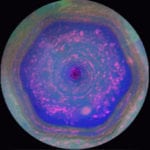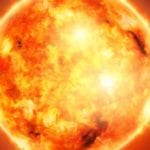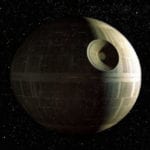 Weird Stuff
Weird Stuff  Weird Stuff
Weird Stuff  Mysteries
Mysteries 10 Tragic Disappearances and Deaths in Joshua Tree National Park
 History
History 10 Ways Childhood Really Sucked in the Old West
 Music
Music 10 Name Origins of Famous Bands from the 1990s
 Religion
Religion 10 Biggest Turnarounds by the Catholic Church
 Weird Stuff
Weird Stuff 10 Unbelievable Times Laws Had Unintended Consequences
 Humans
Humans Ten Historic Women Who Deserve Way More Credit Than They Got
 Movies and TV
Movies and TV 10 Films That Spawned Major Lawsuits
 History
History Ten Times Towns Were Wiped Off the Face of the Earth
 Creepy
Creepy 10 of the Most Disturbingly Haunted Public Houses in the UK
 Weird Stuff
Weird Stuff 10 Niche Subcultures That Are More Popular Than You Might Think
 Mysteries
Mysteries 10 Tragic Disappearances and Deaths in Joshua Tree National Park
 History
History 10 Ways Childhood Really Sucked in the Old West
Who's Behind Listverse?

Jamie Frater
Head Editor
Jamie founded Listverse due to an insatiable desire to share fascinating, obscure, and bizarre facts. He has been a guest speaker on numerous national radio and television stations and is a five time published author.
More About Us Music
Music 10 Name Origins of Famous Bands from the 1990s
 Religion
Religion 10 Biggest Turnarounds by the Catholic Church
 Weird Stuff
Weird Stuff 10 Unbelievable Times Laws Had Unintended Consequences
 Humans
Humans Ten Historic Women Who Deserve Way More Credit Than They Got
 Movies and TV
Movies and TV 10 Films That Spawned Major Lawsuits
 History
History Ten Times Towns Were Wiped Off the Face of the Earth
 Creepy
Creepy 10 of the Most Disturbingly Haunted Public Houses in the UK
10 Solar System Mysteries That Baffle Our Best Scientists
Even though we’ve already told you about the mysteries of our solar system here, here, and here, we’re back with more mysterious sights and sounds that baffle our best scientists. At least one of them has fueled conspiracy theories, but that’s just part of the fun.
10Mysterious ‘Sounds’ In Space
The video above presents five mysterious “sounds” from space, three of which are definitely within our solar system. All of the sounds are actually radio waves or plasma waves translated into sound that humans can hear.
First, we hear the eerie sounds that NASA’s Cassini spacecraft detected as radio emissions from Saturn’s poles in April 2002. The variations in frequency and time corresponded to activity in Saturn’s auroras, like the radio emissions from our own northern and southern lights. Scientists believe the complex band of rising and falling tones came from many small radio sources that moved along Saturn’s magnetic field lines near its polar regions. Conspiracy theorists think it sounds like alien speech.
Second, we hear NASA’s Voyager I enter interstellar space (if you don’t count the Oort cloud) in 2012. That’s the farthest any of our spacecraft have traveled from Earth. It took 35 years to hear the eerie sound of that dense plasma (ionized gas) vibrating as it collided with a blast wave from an eruption on the Sun.
Third, we hear “xylophone music” from Comet 67P/Churyumov-Gerasimenko, as recorded by the Rosetta spacecraft in August 2014. Scientists believe the music comes from “oscillations in the magnetic field in the comet’s environment,” according to an ESA blog post. “To make the music audible to the human ear, the frequencies [were] increased by a factor of about 10,000.” Even now, it’s a mystery exactly how those oscillations work.
Next, we hear the whistling sound (electromagnetic “whistler” emissions) of lightning on Jupiter, as recorded by Voyager. When the emitted waves hit the plasma above the planet, the higher frequencies moved faster than the lower frequencies along Jupiter’s magnetic field. That’s why we hear those otherworldly whistling effects, which sound like Gorn weapons attacking the Enterprise landing party in the Star Trek episode “Arena.”
Finally, we hear the “heartbeat” of a feeding black hole in binary star system GRS 1915+105, as recorded by NASA’s Rossi X-ray Timing Explorer in 1996 and converted to sound by scientists at MIT. NASA also recorded a heartbeat from the black hole in system IGR J17091-3624 in 2003.
9Hidden Magnetic Portals Around Earth
If you’re familiar with the science fiction concept of a wormhole—a tunnel shortcut connecting two distant places in outer space—then you understand what a magnetic portal is. The difference is that magnetic portals are known to be real. They’re hidden all around Earth, opening and closing dozens of times every day. They’re also unstable, invisible, and usually short-lived. For the brief time we’ve known about them, they’ve been hard to predict. But that may be changing.
Earth is surrounded by a magnetosphere, an invisible magnetic field generated by our planet’s molten core. In the upper atmosphere, the lines of magnetic force between our planet and the Sun sometimes meet to form X-points, openings to these hidden magnetic portals. Each portal forms an unbroken, 150-million-kilometer (90 million mi) path from Earth’s atmosphere to the Sun’s atmosphere, allowing large numbers of solar particles to quickly flow into our magnetosphere if the portal stays open long enough. When that happens, these solar particles can produce geomagnetic storms, possibly causing auroras and disruptions to our electrical grids.
Plasma physicist Jack Scudder found that we may be able to predict X-points. “We have found five simple combinations of magnetic field and energetic particle measurements that tell us when we’ve come across an X-point or an electron diffusion region,” said Scudder. “A single spacecraft, properly instrumented, can make these measurements.”
NASA’s Magnetospheric Multiscale Mission was launched in early 2015 to look for these magnetic portals and gather more information about them.
8Dark Lightning
Although the risk is believed to be small, you may already have been hit by dark lightning—and its beams of antimatter—without knowing it.
Dark lightning is also known as “terrestrial gamma-ray flashes.” Thunderstorms not only produce electricity through visible lightning—they also produce powerful flashes of radiation through silent dark lightning that’s nearly invisible. Gamma ray emissions are typically associated with nuclear explosions, supermassive black holes, and supernovas. So it was a surprise to find these emissions coming from thunderstorms.
While visible lightning moves from cloud to cloud or between cloud and ground in a bolt formation, dark lightning flies upward in all directions toward space, including into the airspace where commercial planes fly. If you’re a frequent flier, you may be getting blasted with radiation more often than you realize. We also know that dark lightning spews space with positrons, the antimatter equivalent of electrons.
Scientists believe your radiation dose from a hit of dark lightning is probably equivalent to having a CT scan, but they don’t know for sure. If you receive enough radiation one time or cumulatively, your body might be damaged by dark lightning. But you won’t suffer the noticeable harm that occurs with a direct hit by visible lightning.
The risk of being zapped by dark lightning is small because airline pilots try to avoid flying through thunderstorms. “Doses never seem to reach truly dangerous levels,” said physicist Joseph Dwyer. “The radiation from dark lightning is not something that people need to be frightened about, and it is not a reason to avoid flying. I would have no problem getting on a plane with my kids.”
There’s a lot we don’t know about dark lightning. Although we believe it’s produced when high-energy electrons smash into air molecules during a thunderstorm, we don’t know exactly how visible lightning and dark lightning are related. We also aren’t sure how often dark lightning occurs or if anyone has ever been hit by it.
7Mysterious Bright Spots On Ceres

Previously, we told you that Feature 5, a bright spot on the surface of dwarf planet Ceres, might be a cryovolcano, a water-erupting volcano that may indicate an underground ocean. Now, newer pictures from NASA’s Dawn spacecraft are adding to the mystery.
First, we saw another bright spot, called “Feature 1,” on Ceres’s surface. But the two spots looked different when viewed in thermal images. Feature 1 showed up as a dark spot in infrared images, meaning it was cooler than the area surrounding it. However, Feature 5 didn’t appear at all in thermal images, so its temperature was the same as its surroundings. We don’t know what this means yet. It may be that the spots are made of different material or the ground surrounding them is different.
The next round of images only deepened the mystery. Instead of only two spots, we found that the spots are actually several separate bright points of various sizes that have a central cluster. The brightest spots are contained in a crater about 90 kilometers (55 mi) wide.
“The bright spots in this configuration make Ceres unique from anything we’ve seen before in the solar system,” said Christopher Russell, who leads the Dawn mission. “The science team is working to understand their source. Reflection from ice is the leading candidate in my mind, but the team continues to consider alternate possibilities, such as salt.”
Ceres is also missing the large surface craters that we expected to see. “When we compare the size of [Ceres’s] craters with those we see on [protoplanet] Vesta, we are missing several larger craters,” said Russell. “That’s something we’ve got to learn more about.”
However, Ceres shows more evidence of activity like landslides and flows on its surface than Vesta does. Ceres also has a steep mountain rising from a rather smooth surface.
6Mercury Just Doesn’t Make Sense
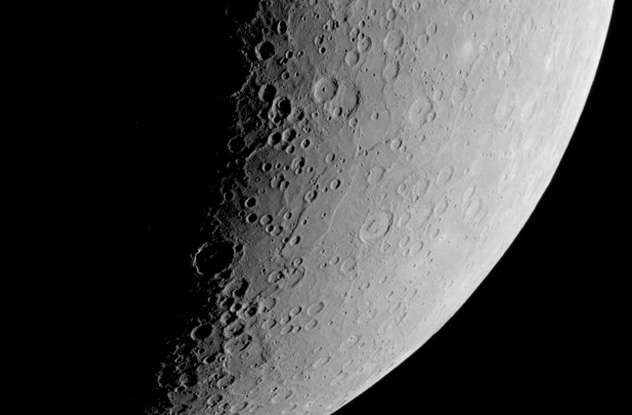
For four years, NASA’s MESSENGER spacecraft orbited Mercury, sending us pictures of cliffs (aka “fault scarps”) that looked like enormous stair steps. The biggest ones were over 1,000 kilometers (600 mi) long and over 3,000 meters (10,000 ft) high.
Fault scarps are created when rocks are pushed into these patterns along fractures in the crust of a planet. For Mercury, many scientists believe the scarps are surface “wrinkles” that were created when the planet shrank by up to 14 kilometers (9 mi) in diameter as its core transformed from molten to solid. Still, the scarps don’t look right. If they formed due to shrinkage, they should be uniform across Mercury’s surface. Instead, the majority of scarps run along two wide strips from north to south on either side of the planet. Also, there are only half as many scarps in the northern hemisphere as in the southern hemisphere.
But that’s not the only strange thing about Mercury. It’s also too far from the Sun.
As scientists have studied data from NASA’s Kepler spacecraft, they’ve noticed that only one other solar system looks like ours. In fact, many stars are surrounded by Systems of Tightly packed Inner Planets (STIPs). Over time, collisions between these inner planets leave only a few survivors. If scientists are modeling this correctly, our solar system had up to four more planets orbiting inside of Venus in earlier times. When all the collisions were over, Mercury was the sole survivor.
That may explain why Mercury contains too many heavier elements and not enough lighter elements. Maybe collisions with other space objects ripped away the planet’s lighter crust, exposing a denser layer. It might also account for why models of our solar system show that we had too much material orbiting the Sun to form only one planet as close as Mercury.
“If every star once had a system of STIPs, then it would mean that the modelers have been missing the boat on planetary formation for a long time,” said scientist Kevin Walsh. “We have always been trying to build models just to get our four rocky planets, whereas if this idea is right, then we have long ignored the possibility of also forming three to five planets as big as or even much bigger than Earth inside the orbit of Mercury. This would be extremely cool!”
5Mysterious Cloud-Like Plumes Over Mars
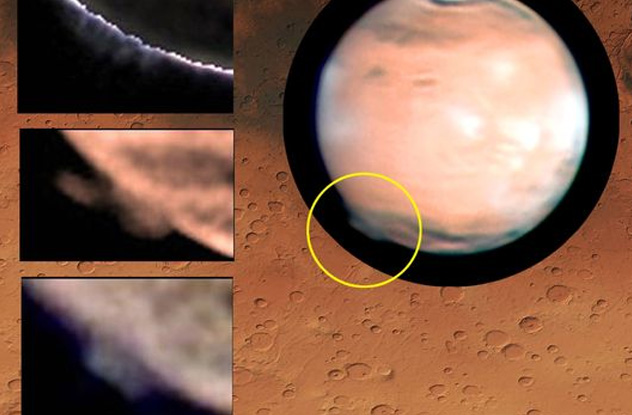
In early 2012, amateur astronomer Wayne Jaeschke spotted a strange cloud over Mars. Unlike the thin, wispy clouds that normally form over the planet, these monster flares erupting from the surface topped out at an altitude of 240 kilometers (150 mi), appearing to be over twice as high as any previous cloud. They were also extremely wide at 500–1,000 kilometers (300–600 mi) across.
The first plumes lasted a little over a week in March 2012. Similar plumes appeared briefly in April 2012. Even after consulting other amateur astronomers, Jaeschke couldn’t account for what he saw. So he brought his findings to the pros, but they were stumped, too.
After checking historical data, professional astronomers found Hubble Space Telescope images from 1997 that showed a similar cloud on Mars. The pros concluded that the odd plumes weren’t made of ice crystals because the atmosphere on Mars is too warm for that. It was also unlikely that the plumes were an aurora, similar to the northern lights on our planet. The type of solar activity needed to create an aurora was absent on the days the Martian plumes appeared. Still, they were 1,000 times more luminous than anything ever observed on Earth.
Not all planetary scientists believe these plumes are real. But the rest argue that 19 different observers recorded the odd eruptions.
In a separate finding from NASA’s Mars orbiter, scientists have spotted evidence of “impact glass” in some craters on Mars. Dark in color like newly cooled lava, impact glass forms when a comet or asteroid smashes into a planetary surface and melts a large area of rock and soil that quickly hardens.
This material can preserve traces of life that survived before and after impact, almost like a time capsule. Impact glass can also trap atmospheric gases existing when the crash occurred. So if we can find a way to examine it, impact glass may solve some ancient mysteries about the Red Planet.
4The Origin Of Russia’s Asteroid
In February 2013, an undetected meteor 20 meters (65 ft) wide exploded with the power of 30 Hiroshima bombs over Chelyabinsk, Russia, just east of the Ural Mountains. Fortunately, no one died. But a shock wave hit the city about a minute later, causing over 1,200 injuries from the flying glass of shattered windows.
Over two years later, we still don’t know the origin of the meteor. At first, we thought it was a chunk of 1999 NC43, a near-Earth asteroid that’s about 2 kilometers (1 mi) wide. But it seems the only thing they shared was a similar orbit around Earth. “The composition of [the] Chelyabinsk meteorite that was recovered after the event is similar to a common type of meteorite called LL chondrites,” said scientist Vishnu Reddy. “The near-Earth asteroid has a composition that is distinctly different from this.” Ultimately, scientists had to admit that they can’t easily link a meteor to a specific asteroid because the majority of asteroids are extremely small and have chaotic orbits.
We were lucky that the Chelyabinsk meteor didn’t explode closer to the ground, causing even more injuries and damage. But it served as a warning that we need to search preemptively for asteroids that could be hazardous to us. As a result, the ESA created an asteroid warning center. In 2018, the nonprofit B612 Foundation, an organization dedicated to protecting Earth from asteroids, also expects to launch the Sentinel Space Telescope to search for asteroids. If we can find them soon enough, we have the technology to prevent future catastrophes from meteors in a cost-effective way.
3Pluto’s Miniature Solar System
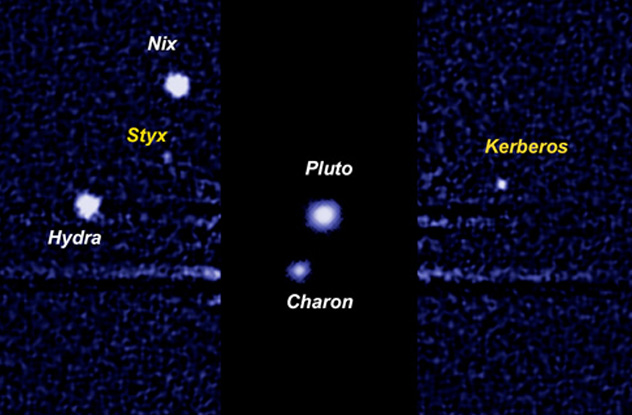
Unlike anything we’ve seen before, Pluto and its five moons resemble a miniature solar system. Scientists believe that Charon, the largest moon, was created from a collision between Pluto and an unknown large object. The other moons—Hydra, Kerberos, Nix, and Styx—may have formed out of the debris from that impact. If that’s true, all the moons should look alike. They don’t.
Using photos from the Hubble Space Telescope, scientists realized that Kerberos is darker than Hydra, Nix, and Styx. If they all formed from the same impact, that doesn’t make sense. So where did Kerberos come from?
Maybe Pluto captured Kerberos in a collision with a different object. However, if Kerberos formed from the same crash that created the other moons, it may simply be a darker piece of the colliding object’s core. That doesn’t really explain the color difference, though. Scientists believe the colors of the moons would have become similar as they swapped material with each other over the billions of years they’ve existed.
According to another theory, the moons are all the same inside, even if Kerberos looks different on the outside. But we’re too far away to be able to make that determination. One final theory is that Kerberos looks different because it has a different shape, perhaps like a doughnut or potato, when compared to its fellow moons.
The other surprise for scientists is that Hydra, Nix, and Styx are in a Laplace resonance, which means they exert gravitational influences on each other to lock their orbits into a kind of cosmic dance around Pluto. In our solar system, only Jupiter’s moons Europa, Ganymede, and Io are in that kind of orbital resonance.
In general, orbital resonance means that the gravitational influence of at least two objects locks them in orbit around a parent body in a distinct pattern. For example, Pluto and Neptune are in a 2:3 resonance. Pluto makes two orbits around the Sun (its parent body) for every three that Neptune makes.
2X-Files From The Edge Of Space
It’s been about 50 years since we recorded atmospheric infrasound, sound waves below 20 hertz in frequency. Those frequencies are below the human capacity to hear, so the sounds on the video above have been made 1,000 times faster to be audible. Daniel Bowman, the University of North Carolina graduate student who recorded them, thinks the eerie hisses, crackles, and whistles sound like something from The X-Files. To others, it sounds like radio interference.
Scientists are intrigued by the sounds because they can’t explain their origin. As part of the High Altitude Student Platform (HASP) in 2014, Bowman flew for nine hours on a high-altitude balloon to over 37,500 meters (125,000 ft) above the Earth’s surface. That atmospheric region is called “near space,” below outer space where satellites orbit but above commercial airspace where airplanes fly. With equipment he built himself, Bowman was the first person to record infrasound at that height.
Although scientists in the 1960s believed that atmospheric infrasound would be a good way to identify nuclear explosions, their interest subsided when ground-based sensors were able to do the job. So the complexity of Bowman’s recordings over New Mexico caught today’s scientists by surprise. They intend to send another HASP balloon to investigate the unusual infrasound. “I think this work has opened new ground for more research,” said geophysicist Omar Marcillo. “It’s very important for the entire community.”
So far, serious scientists don’t think the source is aliens. Weather events like storms can create infrasonic sound waves. So can earthquakes, meteors, and volcanoes. As to what produced the infrasound on this recording, scientific guesses include clear air turbulence, wind turbulence, crashing ocean waves, gravity waves, signals from a nearby wind farm, and vibrations from the balloon’s cable.
1Planet X

As recently as 2014, scientists were claiming that Planet X, a planet hypothesized to lie beyond Pluto in our solar system, did not exist. But in early 2015, researchers changed their tune. After analyzing the orbits of 13 extreme trans-Neptunian objects (ETNOs)—distant bodies like dwarf planets Sedna and 2012 VP113 that orbit the Sun beyond Pluto—some scientists now believe that at least two more planets bigger than Earth, Planet X and Planet Y, may really be out there.
Theoretically, the ETNO orbits should be an average of 150 astronomical units (AU) from the Sun. An AU equals about 150 million kilometers (90 million mi), the distance between Earth and the Sun. These orbits are also predicted to be inclined at about zero degrees. But the theory doesn’t agree with reality. The 13 ETNOs have actual orbits with an average distance between 150 and 525 AU and inclinations averaging around 20 degrees.
“This excess of objects with unexpected orbital parameters makes us believe that some invisible forces are altering the distribution of the orbital elements of the ETNOs, and we consider that the most probable explanation is that other unknown planets exist beyond Neptune and Pluto,” said lead researcher Carlos de la Fuente Marcos. “The exact number is uncertain . . . but our calculations suggest that there are at least two planets, and probably more, within the confines of our solar system.”
Of course, there could be other explanations for these unexpected orbits. But given that we didn’t think anything was beyond Pluto in our solar system until 1992 and we only recently found 2012 VP113, no one can say with certainty that more planetary bodies don’t exist in the outer reaches of our solar system. Our technology isn’t advanced enough to detect everything yet.
